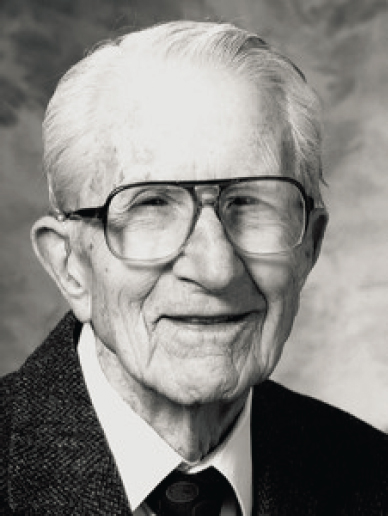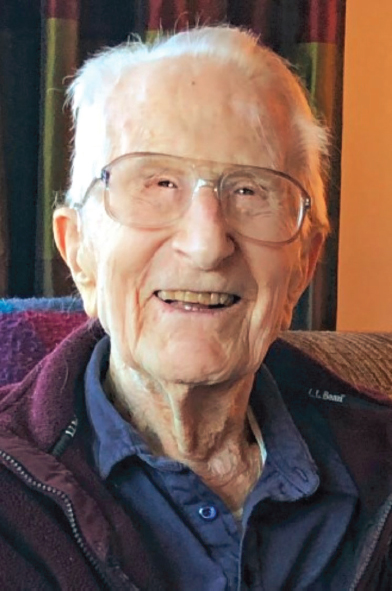MAX W. CARBON
1922–2021
Elected in 2012
“For establishing engineering educational programs for nuclear reactor design and safety.”
BY MICHAEL CORRADINI
MAX WILLIAM CARBON, a major force in establishing nuclear engineering educational programs, died June 23, 2021, at his home in Middleton, Wisconsin, at the age of 99.
He was born January 19, 1922, in Monon, Indiana, the son of Joseph William and Mary Olive (née Goble) Carbon. He attended Purdue University, where he earned his bachelor’s degree in mechanical engineering in 1943. He met Phyllis Camille Myers, an undergraduate at Indiana University, on a blind date and they married on April 13, 1944.
After graduation Max joined the US Army as a corporal. During World War II he served in the Ordnance Department in New Guinea, the Philippines, and Japan (1943–46) before retiring to the US Army Reserve as a captain. He returned to Purdue and, as a DuPont Fellow in mechanical engineering, earned his master’s degree in 1947 and PhD in 1949.
From February 1949 until September 1955, he worked at the General Electric Company’s Hanford Works in Richland, Washington, producing plutonium for atomic and hydrogen bombs used for national defense. His primary duty was as head of the heat transfer group, which was responsible for the safety analysis, operating limits, and cooling technology that allowed for increased plutonium production and extended reactor lifetimes. As group head, Max played a
significant role in increasing production by a factor of four over initial design.
He subsequently joined the Avco Manufacturing Corp. as head of its thermodynamics section, successfully designing the nose cone for the Titan intercontinental ballistic missile.
Max came to the University of Wisconsin–Madison in 1958 to establish a nuclear engineering program as part of a growing postwar research emphasis on designing better, more efficient nuclear power plants for generating electricity. In 1961, as the program grew, he became the first chair of the new Department of Nuclear Engineering and led in establishing bachelor’s, master’s, and PhD curricula; its academic programs were soon consistently ranked among the nation’s highest.
As department chair, he considered it a critical component of his responsibilities to recruit, hire, and mentor top faculty and staff—many of whom ultimately were elected to the National Academy of Engineering. In addition, he strongly supported the practice of “research teaching”—in which students learn research techniques and methods and how to study and work independently of an advisor—as a necessary complement to formal classroom instruction. He was one of the major advisors for undergraduates in nuclear engineering at Wisconsin and supervised more than a dozen master’s and PhD students. He also oversaw construction of the university’s research and training nuclear reactor, which achieved initial criticality in early 1961.
Max served as department chair for 34 years, until his retirement in 1992, when he was named professor emeritus. During his tenure he oversaw the addition of plasma physics to create today’s Department of Engineering Physics.
Max helped to define, advance, and champion the field of reactor safety and heat transfer not only in the technical community but also with the public, in educational efforts about the importance of nuclear power. He headed a Ford Foundation project developing college-level engineering education programs in Singapore (1967–68), and authored Nuclear Power: Villain or Victim? Our Most Misunderstood Source of
Electricity (Pebble Beach Pub., 1997). Written for nontechnical audiences, the book clearly explains the benefits and risks of nuclear power; now in its fifth printing, it has been translated into three other languages.
Max served on the Nuclear Regulatory Commission’s Advisory Committee on Reactor Safeguards (1976–88), and as chair in 1979. He consulted for the nuclear power industry in several capacities throughout his career with a focus on safety. For example, he chaired the University of Chicago Review Committee on the Integral Fast Reactor (1983–95); the IFR was a pioneering design by Argonne National Laboratory that evolved into the GE Prism and Terrapower Natrium reactor designs.
Max’s honors include being named a fellow of the American Nuclear Society in 1975 and elected to the National Academy of Engineering in 2012.
On the lighter side, Max enjoyed countless fishing trips to Canada and Alaska with friends and family members; walleye and salmon were favorites. He and Phyllis traveled the world extensively, and were especially fond of Australia, New Zealand, and countries in Asia. As they got older, they continued to enjoy their annual vacations in Costa Rica (but not until after the Super Bowl game) and on the coast of Maine, eating lobster, blueberry muffins, and strawberry pies and listening to crashing waves. Max and Phyllis were champion bridge and duplicate bridge players, and he enjoyed cards of any sort with anyone bold enough to challenge him. He won his last game of rummy the day before he passed away.
Phyllis, Max’s bride of 76 years, preceded him in death by one year. They are survived by their children Ronald, Jean Dabel (John), Susan Carbon (Larry Berkson), David (Danhong Chen), and Janet Corradini (Michael). They were loved by 13 grandchildren and 12 great-grandchildren.






